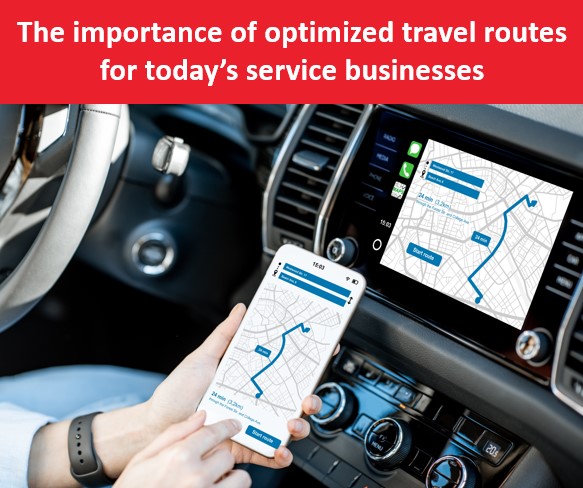
- Field Service Management
- Field Service Software
- mobile
The Power of Mobile-First: Why Mobile Devices Are Critical for Digital Transformation in Field Service Management
At Praxedo, we talk extensively about the importance of mobile technology in field service management. Some of the reasons include the following:
- Mobile is intuitive and easily fits into technicians’ workflows
- Tablets and smartphones are more straightforward for field workers to use
- Data collection (i.e. for billing, work order management, and other processes) is more streamlined with mobile
- Technicians save time using mobile devices, in the moment, rather than waiting to return to a computer (in their vehicle or office) to update their records
- Field service teams are better equipped to deliver real-time status updates to customers who may themselves be under pressure
All of these reasons roll up into a bigger picture of time and cost savings, through increased efficiency. But there’s more to the story, and it’s important to understand the underlying reason why.
If you’re responsible for leading a digital transformation project at your field service management organization, you are likely making tradeoffs between different solutions — and hearing sales pitches from many different vendors who all promise exceptional results. By understanding the philosophy behind mobile-first thinking, you’ll be in a better position to choose the most practical and on-target solution for the unique needs of your field service organization. This capability will help you improve the outcomes of your digital transformation strategy, overall.
Here’s a look into the connection between mobile-first technology and a successful digital transformation strategy.
The connection between mobile and digital transformation
The topic of digital transformation is top of mind for every field service company.
Facing talent shortages, rising materials costs, and increased workloads, the majority of companies will require technology upgrades to keep up with an accelerating pace of change.
Meanwhile, a range of different technologies including augmented reality (AR), virtual reality (VR), the internet of things (IoT), and countless other solutions are entering the market. How can you make sure that you’re choosing the right options and choosing technologies that will be a value-add rather than a distraction to your field service management team? The answer to this question will make or break whether your digital transformation effort is ultimately successful.
Getting the digital transformation equation right is critical for a field service organization’s ability to remain on-point with changes in the market. A critical first step is to choose solutions that are enjoyable for field service technicians to use. Think about it: is a person, who works with their hands for a living in the field, going to have an easier time updating back-office teams from a laptop or hand-held device?
With so much sophisticated technology entering the market, it’s easy to forget that the most practical — and sometimes simple — platforms are the most intuitive. Usability is crucial, especially, to ensure that digital transformation is successful over the long-term.
“The implementation of a mobile field service management platform will over time yield actionable service history and equipment data that, if monitored, can help companies get out in front of customer complaints, as well as identify opportunities to upsell or cross-sell,” writes Ryan Gottfried, an expert in building field service management technology, for Forbes.
Not having personnel dedicated to analyzing this data, undermines one of the main benefits of putting your field force on a technology platform.”
Connecting the dots: a mobile-first approach is essential to ensuring that your digital transformation strategy is a success. The reason? The technology is easier for field service technicians to use on a practical level. Mobile reduces barriers to technology adoption.
What, exactly, does the phrase ‘mobile-first’ mean?
What exactly does mobile-first mean anyway, especially within the context of field service management?
The phrase refers specifically to a user experience (UX) concept at the intersection of design thinking, human psychology, and engineering.
According to the Interaction Design Foundation, a leading educational institution in the field of UX, the phrase mobile-first refers specifically to “embracing the constraints of smaller screens and focusing on what’s indispensable for users.”
Here are some characteristics of a well-designed mobile application for field service management:
- Simplicity. Mobile-first experiences are free from distractions.
- Visual hierarchy. Designs tailored to smartphones have a clear information priority system, which makes it easy for software users to see what’s important
- Easy scanning. Users don’t need to read to capture the information that they need
- Complexity reduction. Apps enable simple gestures that are based on intuitive clicks, taps, and swipes.
- Tactile and accessible. People of varying abilities and skill levels can easily make the most out of the field service mobile app’s features.
In the field service management industry, mobile-first tech helps technicians stay focused and minimize distractions. UX considerations directly connect with performance on-the-job.
A mobile-first approach improves customer responsiveness
Almost every field service and mobile workforce management organization is facing the pressures of heavy workloads. There aren’t enough hours in the day to meet every customer request. A mobile-first approach to digital transformation can help with this pain point.
As one example, some companies are choosing to implement workflows for remote diagnostics. ViiBE is a mobile-first application that helps technicians troubleshoot problems over the phone. Here’s how it works:
- A customer who encounters an incident can video call the hotline for support
- Dispatch teams can qualify the issue using Viibe before sending a technician
- A technician is dispatched to the site to resolve the issue
- If further support is needed, the technician can video call dispatch for further support
- The incident is resolved
With remote diagnostics, field service organizations can better optimize limited resources such as time and human bandwidth. As a result, digital transformation contributes to a higher first time fix rate.
Mobile-first tech enables better work cultures
Even top-performing field service organizations are dealing with talent shortages. There are two reasons why: experienced professionals are leaving the field, and younger people aren’t entering the profession.
Here’s how mobile-first tech solves both problems:
Improving technician safety
Unpredictable conditions and heavy workloads mean that field technicians often face potentially hazardous conditions. Equipment failures and machinery issues are among the most common OSHA violations. In 2020 alone, there were more than 2.6 million non-fatal injuries in private industry companies, according to the U.S. Bureau of Labor Statistics. Even worse, fatalities rose between 2020 and 2021.
Facing these challenges, mobile technology has the potential to be a solution for ensuring worker safety. Because mobile devices are intuitive to use, workers are less prone to distraction. Meanwhile, smartphones and tablets can embed compliance requirements into in-app educational experiences. Through these learning experiences with just-in-time information, field service teams can improve safety in the field.
Gen Z recruitment
People under the age of 30 never knew a world without a smartphone. This generation is also looking for more training opportunities in hard skills development. With more experienced professionals leaving the profession, organizations are experiencing a knowledge drain.
Imagine being 18 years old, a newcomer to the workforce, and needing to learn new field technician hard skills on the job. How can new talent learn in the best way possible?
It’s estimated that mobile learning increases employee engagement by 50% with 94% of Gen Z using smartphones for educational purposes. In other words, a field service management app can make information consumption easier by integrating learning into the everyday experience.
When you have a strong work culture, built on a foundation of learning, more people will want to work for your organization — which improves Gen Z talent recruitment and retention overall.
Final thoughts
In field service management, the power of mobile-first strategies has become indispensable for businesses seeking a seamless digital transformation. Mobile devices have revolutionized how mobile workers, particularly field technicians, engage with their tasks, making the work order process more efficient and enhancing overall field service management.
The advent of field service mobile apps and mobile workforce management systems has empowered field personnel by providing real-time access to critical information, allowing them to manage mobile operations effortlessly. Customers now expect a higher level of service, and mobile-first approaches are essential in meeting these expectations.
Through the integration of mobile field service software, service organizations can streamline processes, generate service reports on the go, and significantly improve customer satisfaction. The real-time capabilities of mobile apps not only enhance the speed of task completion but also contribute to an enhanced customer experience.
In essence, the adoption of mobile-first strategies, coupled with robust mobile workforce management software, is a catalyst for digital transformation in field service, ensuring that businesses stay agile, responsive, and at the forefront of technological advancements.
About Praxedo
Implementing the right mobile-first technology will require a strong sense of partnership with an external vendor. Working with more than 1,300 companies, Praxedo has developed a birds’ eye view of many different pain points, solutions, and results.
Our singular focus, as a company, is to help field service teams remain empowered. While our core product is field service management software, we are in the business of human relationships.
Your technology is only as powerful as it is straightforward to use. Our team will ensure that you have the consulting and support you need, along the way, to make your best decision. Get in touch to book a demo with us, today.
Our similar articles.
-
- Software
- Productivity
- Field Service Management
- Optimization
The importance of optimized travel routes for today’s service businesses
May 12, 2022 -
- Field Service Management
- fsm
- Service Technician
- AI in field service management
Are Your Field Technicians Working Harder, Not Smarter? How Mobile Apps Can Help.
July 1, 2025 -
- Field Service Management
- Optimization
Top Challenges of Managing Field Service Teams Remotely
July 22, 2024


